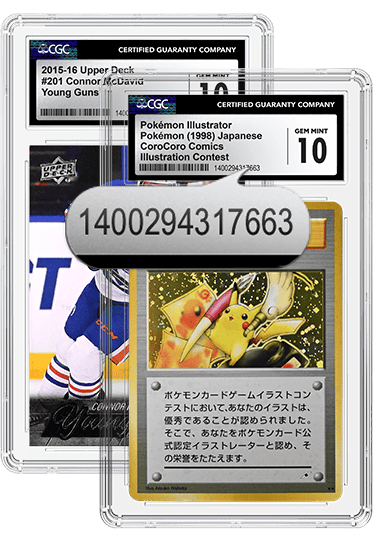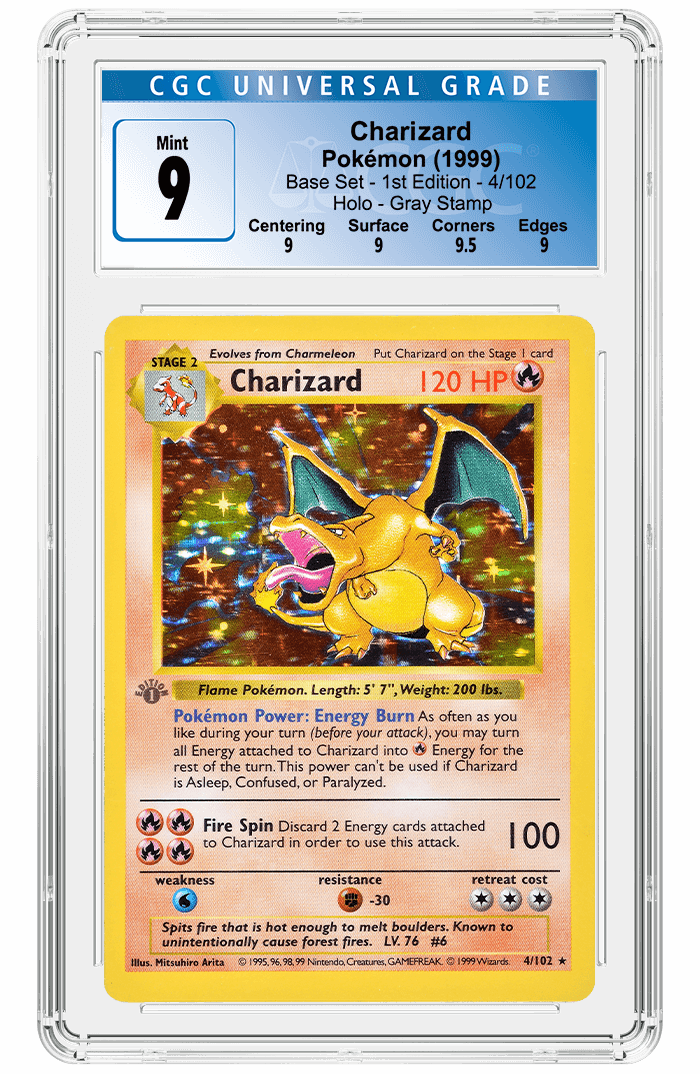Counterfeit Card Alert: Test Print Blastoise
Posted on 12/7/2023
By
Paul Sandler
Director of Product Development
In 2020, CGC Cards™ authenticated, graded and encapsulated four rare Pokémon Test Print Blastoise cards. Since then, two additional genuine examples have been certified by CGC Cards. However, CGC Cards’ graders recently received an interesting card in an Economy submission. While at first, the card appeared to be a Test Print Blastoise with a Magic: The Gathering (MTG) backing, it was, in fact, a counterfeit Blastoise that had been printed on a genuine MTG back.
Even at first glance, the counterfeit card clearly looks different than the genuine example. The level of contrast in the artwork of the counterfeit example looks a bit low, and the entire card appears a bit washed out. There is also a red tinge to the artwork and the art box, especially in the top right corner.
While CGC Cards’ graders were able to easily identify the card as a fake, it is always helpful to dive deeper into the authentication process to show all of the different ways that this card differs from a genuine example.
Taking a closer look
 |
 |
| The green dot from the MTG backing on the back of the counterfeit card (left) and that of a genuine example (right). Click images to enlarge. |
|
The two green dots pictured above may look very similar. There is a good reason for that — the back of the counterfeit Blastoise card is, in fact, a genuine Magic: The Gathering card. Because of this, the well-known “Green Dot Test” — which looks for the four red dots in an “L” shape within the shine on the dot — will still work on the counterfeit card. Below, you can see that the printing plate alignment angles for Magenta, Yellow and Black are the same for both cards as well.
Meanwhile, the fronts of the cards reveal many apparent differences when compared.
One of the first details that jumps out is how much darker the black colors are on the genuine Blastoise. It appears to have much better saturation. It is likely that the saturation on the counterfeit card was reduced because the counterfeiter would not have had the original art files and would have had to use a photo of the card as a starting point.
In addition, note the loss of definition in the shine on Blastoise’s shell. On the genuine card, the shape of the white shine on the shell is amorphous. On the counterfeit card, the shine appears very circular and has well-defined edges.
A close-up of Blastoise’s ears reveals further inaccuracies:
 |
 |
| A close-up image of the counterfeit (left) and a genuine Test Print Blastoise (right). Click images to enlarge. |
|
While the back of the card had the same plate angles as a genuine example because it was printed from the original files, the plate angles for the front of the card are different than a genuine example. Examining just one color on the front of the card (Cyan) reveals that the plate angles differ drastically, indicating that the card was printed using counterfeit printing plates that aren’t the same as the original.
Evaluating differences with specialized lighting
To further test the makeup of the card, the counterfeit Blastoise was subjected to specialized lighting sources using some of CGC Cards’ advanced authentication technology. These additional lighting sources help to show that the inks used to create the counterfeit are not the same as a genuine example.
 |
 |
| The counterfeit card (left) and genuine card (right) under spot fluorescent lighting. Click images to enlarge. |
|
Under spot fluorescent lighting, the cards both appear in black and white. However, there are subtle differences in the way in which the backgrounds react in the text area below the art. Like the shine on Blastoise’s shell from above, the black background on the genuine card has much more detail, whereas the dark areas have merged into larger, solid masses on the counterfeit example. This same loss of shine is also noticeable on the top left quadrant of the electric energy weakness symbol on the counterfeit card.
 |
 |
| Close-up photos of the right arm of Blastoise on the counterfeit card (left) and a genuine example (right). Click images to enlarge. |
|
Also, note the right arm of Blastoise on both cards. On the counterfeit, the lighter area of the arm on top (in the visual spectrum) also appears lighter under Spot Fluorescent lighting. However, when examining the genuine example under Spot Fluorescent lighting, we see that the light area of the arm (in the visual spectrum) actually appears darker under the specialized light. This difference comes from the way that the different inks interact with the light source.
 |
 |
| The counterfeit card (left) and the genuine example (right) under Side Infrared lighting. Click images to enlarge. |
|
CGC Cards also inspected both Blastoise cards under Side Infrared lighting, which uses infrared light at a low angle to highlight any surface imperfections on the cards. As highlighted in the photo above, many design elements on the counterfeit example react differently than those on the genuine card. For example, Blastoise appears to be sitting on top of the counterfeit card, while Blastoise instead looks like it is part of the card in the genuine example. The same can be observed with the energy symbols, which cast a bit of a shadow on the counterfeit example. Finally, note the difference between the two cards when examining the shading of the evolution box and the dark areas on Blastoise.
X-ray fluorescence analysis
 |
|
| An XRF scan of the counterfeit card (pink) versus two genuine examples (red and green). Click image to enlarge. |
|
In addition to conducting a visual inspection, CGC Cards’ graders used a top-of-the-line X-ray fluorescence (XRF) scanner to examine the chemical makeup of the ink used to print both Blastoise cards. XRF technology uses X-rays to non-destructively excite the atoms of a sample and then measure the resulting activity.
To accomplish this, the same blue water energy symbol was examined on three cards: two genuine Test Print Blastoise cards, and the counterfeit. As you can see in the chart above, the red and green lines — which correspond with the genuine cards — track closely with one another for each of the listed elements. On the other hand, there are some major outliers for the pink line — which represents the counterfeit card. To make these differences a bit clearer, CGC Cards quantified the statistics below:
The above chart examines the direct data provided by the XRF scanner. The percentage difference between the two genuine cards was an average of 4.6% between the two. Meanwhile, the percentage difference between the genuine examples and the counterfeit example was a whopping 192%! Even when removing the huge outlier — Titanium — this still leaves an average difference of almost 54%, which is nearly 12 times the difference between two genuine cards.
Conclusion
Although CGC Cards’ grading team recognized the Test Print Blastoise as a forgery even before subjecting it to specialized testing, CGC Cards feels it is important to always document the authentication process properly for such rare and esoteric cards. The four original Test Print Blastoise cards were with CGC Cards for many months as their physical attributes and provenance were documented, and the same data gathered through that examination was used to examine this counterfeit example. Every card graded by CGC Cards is guaranteed to be authentic and properly graded, and this is backed by the CGC Guarantee.
To learn more about this counterfeit and how it was identified, check out the video below:
Stay Informed
Want news like this delivered to your inbox once a month? Subscribe to the free CGC eNewsletter today!








